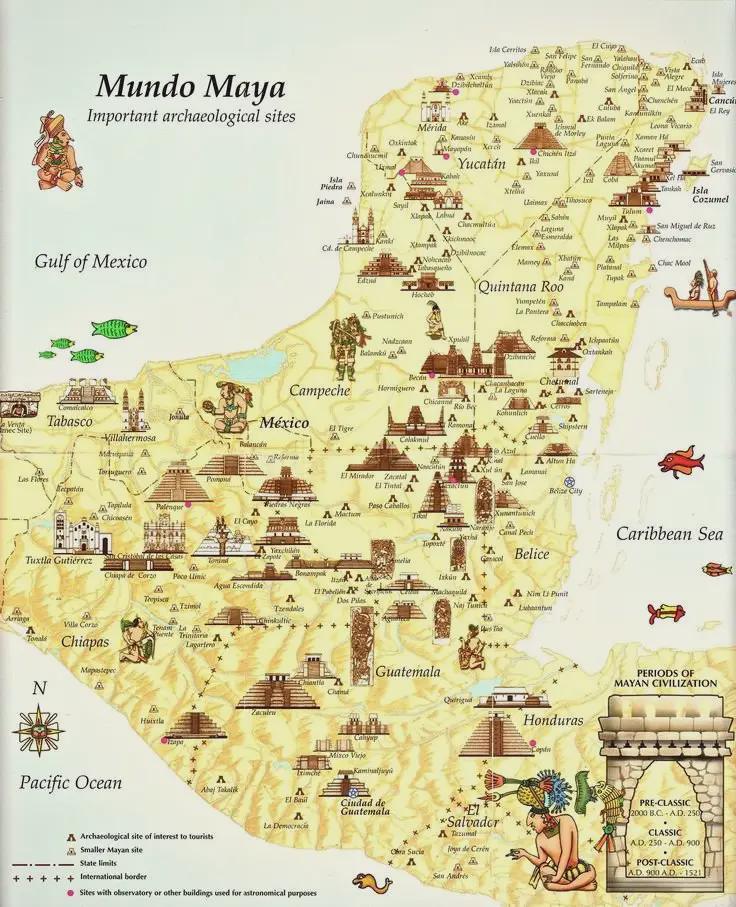Mayan Archaeological Sites Map


Marcus Rodriguez
Historical Geography Expert
Marcus Rodriguez specializes in historical cartography and geographic data analysis. With a background in both history and geography, he brings unique...
Geographic Analysis
What This Map Shows
This map provides a detailed visual representation of the most significant archaeological sites of the ancient Maya civilization, which thrived in Mesoamerica from around 2000 BC until the Spanish conquest in the 16th century. The map highlights key locations, including cities, ceremonial centers, and ruins that reflect the architectural and cultural achievements of the Maya. These sites are not just remnants of a past civilization; they are vital keys to understanding the complex social, political, and economic structures that defined the Maya world.
Deep Dive into Mayan Archaeology
The Maya civilization is renowned for its sophisticated culture, which included advancements in mathematics, astronomy, and writing. The archaeological sites scattered across present-day Mexico, Guatemala, Belize, Honduras, and El Salvador showcase the diversity and innovation of the Maya people. Notably, cities like Tikal, Palenque, and Copán stand out due to their monumental architecture and intricate art.
Tikal, located in the heart of the rainforest of Guatemala, was one of the most powerful city-states of the Maya. It features towering pyramids and an extensive urban layout that reflects its significance as a political and economic hub. Interestingly, Tikal’s temples were not only places of worship but also served as astronomical observatories, linking the Maya's understanding of the cosmos with their agricultural practices.
Palenque, on the other hand, is famous for its stunningly preserved ruins and intricate carvings. The Temple of the Inscriptions, which houses the tomb of the Maya ruler Pakal the Great, offers insights into the religious beliefs and burial practices of the Maya. The site also showcases the Maya's advanced knowledge of hydraulics, demonstrated by the sophisticated water systems that supported their agriculture.
Furthermore, Copán is often referred to as the “Paris of the Maya World” due to its artistic achievements and urban planning. The site is renowned for its stelae—large stone slabs carved with detailed hieroglyphics and images that tell the stories of the city's rulers and their accomplishments. Copán’s location near the borders of Guatemala and Honduras also highlights the trade networks that existed between different Maya city-states.
What's fascinating is that these sites are interconnected through a vast network of trade routes, cultural exchanges, and political alliances. The archaeological evidence suggests that the Maya civilization was not a monolithic entity but rather a tapestry of diverse cultures and languages. This complexity is essential for understanding the rise and fall of the Maya, particularly their eventual decline, which is attributed to factors such as environmental degradation, warfare, and societal upheaval.
Regional Analysis
The map delineates various regions of the ancient Maya world, each with its unique characteristics. The northern lowlands, home to Tikal, were primarily agricultural and featured a network of city-states that thrived on maize cultivation. In contrast, the southern highlands, where sites like Palenque and Copán are located, were characterized by a more rugged landscape and often relied on trade with the lowlands for essential resources.
Interestingly, the Maya civilization exhibited significant regional variations in architecture and art. For example, the ornate baroque style seen in Palenque's structures contrasts sharply with the more austere designs found in northern sites. The diversity in artistic expression reflects the varying cultural influences and local resources available in these regions. Furthermore, the map also illustrates the impact of geography on city planning. For instance, cities built near rivers could easily access water for agriculture and trade, while those in mountainous areas had to develop alternative strategies for resource management.
Significance and Impact
Understanding the archaeological sites of the Maya is crucial for several reasons. Firstly, they provide invaluable insights into the social and political organization of one of the most influential civilizations in human history. The study of these sites allows researchers to piece together the dynamics of ancient trade, diplomacy, and cultural exchange.
Moreover, these archaeological sites are not just relics of the past; they are vital for contemporary indigenous communities seeking to preserve their heritage and identity. As global interest in Mayan history grows, these sites increasingly attract tourism, which can offer economic opportunities for local populations but also poses challenges regarding preservation and sustainability.
Current trends suggest a heightened focus on the role of climate change and urbanization in the preservation of these sites. Archaeologists and conservationists are working tirelessly to address these challenges, ensuring that future generations can continue to learn from the remarkable achievements of the Maya civilization. The legacy of the Maya endures, and through the lens of archaeology, we can appreciate the complexity and resilience of this ancient society.
Visualization Details
- Published
- August 15, 2025
- Views
- 144
Comments
Loading comments...